Planting thuja on the site in spring and autumn, caring for plants
Thuja fell in love with the owners of suburban areas for its decorative qualities, ease of care and good survival rate. Due to the variety of species, this plant is widely used in landscape design, as well as for decorating home interiors. Planting a thuja in spring and autumn is not difficult, as well as caring for it.
Varieties
There is a wide variety of thujas, differing in the shape and structure of the crown, shade of needles, and sizes. Thuja western is suitable for planting in almost all regions of Russia (including Siberia). This species is resistant to frost, undemanding to the soil, and requires a minimum of maintenance.
Western thuja is represented by numerous varieties. Let's list the most popular ones.
- Holmstrup. Differs in a narrow-pyramidal dense crown, original in structure. The needles remain dark green at any time of the year. Thuja grows up to 2 m, retains its shape even without haircuts.
- Emerald. The crown is pyramidal, the plant reaches 2 m in height.
- Danica. Dwarf spherical thuja.
- Braband. The cone-shaped crown, in optimal conditions, grows up to 21 m, in central Russia the height does not exceed 4 m.
- Golden Globe. Slowly growing spherical thuja, reaching a diameter of about 1 m by the age of 20. Golden Globe is distinguished by a pronounced golden shade of needles.
- Heather (Erikoides). Dwarf thuja, forming a very fluffy rounded crown. A distinctive feature is the presence of both needle-shaped and flat-awned scaly branches.
- Miriam. A relatively new variety of dwarf spherical thuja, bred on the basis of the Danika variety. In diameter it does not reach more than 80 cm, it is distinguished by the correct shape of the crown and golden color of the needles.
- Woodward. The crown is formed in the form of a ball about 5 m in diameter, the height does not exceed 2.5 m.
- Teeny Tim. Dwarf thuja with a spherical crown shape up to 1.5 m high.
Tall thuja, planted in a row, play the role of a hedge on the site. Dwarf ones can be used to decorate borders, as separate elements. It turns out interesting compositions if you plant a mix of thujas with different shades of the crown, for example: Bodmeri, Sunkist, Zebrina, Danica, Golden Globe. Tui not only decorate the site, but also saturate the air with phytoncides - disinfecting substances. No wonder the word "thuja" is translated from the Greek language as "incense". Mini-varieties can also be grown at home.
Planting seedlings
Thuja seedlings are usually sold in special containers with a closed root system. They are well fertilized and ready for transhipment into open ground at any time of the growing season. However, it is better to plant thuja in spring, so that the plant will fully adapt and assimilate with the soil until winter.
Thuja is undemanding to the soil, but it is not recommended to place it on clayey or wetlands. The following soil composition is well suited:
- river sand;
- sod land;
- peat.
As for illumination, thuja develops well in light partial shade. In some varieties, lack of sunlight negatively affects the appearance: Golden Globe changes color from golden to pale green, and Holmstrup's crown thinns.
Advice
Varieties should be selected taking into account the availability of free space on the site. If a tall columnar thuja is planted, then the distance from it to other trees should be about 3 m. Between the dwarf varieties, 1-1.5 m is quite enough.
Thuja is usually planted in the turf of the lawn, so it is important to properly prepare the hole, the size of which depends on the volume of the seedling earthen clod.It is necessary to leave a reserve for drainage and fertile loose soil so that the roots can expand faster. The hole should be dug 30 cm deeper than the coma height and 40 cm wider. If the soil is heavy, then the bottom deepens another 20 cm to lay the drainage layer: broken brick, expanded clay, fine gravel. Next, a nutritious soil is poured containing compost or rotted manure. Thuja sits in the prepared hole, soil is poured around the earthen coma.
When planting, it is very important not to cover the root collar with earth - the place where the roots go into the trunk. It should be at ground level. Otherwise, the thuja will not grow well and will begin to turn yellow.
After the plant is planted, the soil is compacted a little and gradually spills. You will need 1-2 buckets of water (depending on the age of the thuja). Then the root circle is mulched with peat chips, crushed bark of conifers or their litter. This procedure will help protect the thuja roots that are close to the surface. The root collar and lower branches should be free of mulch.
How to plant thuja seeds
Growing thuja from seeds is advisable if it is planned to arrange long curbs or a hedge in the country. For this design, you will need a lot of planting material. It will take from 3 to 5 years to independently obtain thuja seedlings from seeds. However, it should be noted that new trees may not reproduce the varietal characteristics of the parent plant.
Thuja seeds ripen in cones. They are harvested at the very beginning of autumn before disclosure, after which they are kept warm for a couple of days so that the seeds spill out naturally.
Advice
Thuja seeds should be sown immediately after harvest. After 3 months of storage in a warm place, their germination rate will drop significantly.
The best option is sowing before winter. The seedlings will grow stronger, and there will be little hassle with them. In autumn, thuja seeds can be sown directly in the garden bed or in a buried box. The second method is more convenient, since in the spring it is easy to rearrange the container with seedlings in the greenhouse.
To sow thuja, you need the following soil:
- turf or garden land - 1 part;
- peat - 2 parts;
- sand - 0.5 parts.
The mixture is poured into a box, 2-3 cm remains from the edge. Grooves are cut about 1 cm deep at a distance of 5-6 cm from each other. Thuja seeds are evenly distributed over the entire length of the grooves, filled up, then the soil is crushed with a board. You can mulch crops with 2-3 cm of peat chips and cover with non-woven material (from animals). The box must be installed on the site in a place where direct sunlight does not fall.
In the spring, about 3 weeks after warming up the soil, thuja seeds will sprout. Seedlings will look like thin branches of juniper or spruce, but later (after 2-3 months) real scaly "legs" will appear.
Sowing at home
You can sow thuja in autumn and at home. With this option, the seeds are stratified on the bottom shelf of the refrigerator in a container with wet sand or sawdust. After 2 months (in February) they are removed and sown in a box filled with drainage (2 cm from the bottom) and soil for conifers. Sowing is carried out according to the scheme 1 * 1cm in a checkerboard pattern. When planted at home, thuja seeds are not covered with soil, but are slightly pressed into it, moistened with a spray bottle and covered with a film.
When the roots begin to appear, they are slowly sprinkled with nutritious soil and sprayed with water. After a month, the shelter is removed. Seedlings must be regularly sprayed with water. It is recommended to plant thuja grown at home in the ground only in the third year. In the summer they can be put out on the street, and with the onset of cold weather they can be taken into the house.
Thuja seedlings care
In the first season, young animals must be fed every two weeks with complex mineral fertilizer. You can take the universal for conifers: "Solution" or "Agricola". Over the summer, young thuja will grow up to 7-8 cm.Seedlings of street sowing remain overwintering in the same place, covered with a special material or a hut made of spruce branches.
In the second year, the grown young thuja (street) can be planted in a special garden bed, where they will grow to a "marketable" species. The place should be chosen in light partial shade. The soil is dug onto a shovel bayonet, the following fertilizers are applied (1 m2):
- humus bucket;
- 40 g nitroammophoska;
- 250-300 g of ash.
Thuja seedlings are planted according to the 30 * 30 cm scheme. The root collar should be at the level of the soil, otherwise the sprout will vytryut. Planting should be watered as the soil dries up, fertilizing is carried out every 3 weeks.
In the third year, young thujas reach about 50 cm in height, they can already be transplanted to a permanent place.
Advice
In order for a thuja hedge to look spectacular, their crowns must be of a uniform structure. When sowing with seeds, the quality of the seedlings may vary, so when planting them next to them in a permanent place, similar specimens should be selected.
Planting by cuttings
Planting a thuja with cuttings is a much less painstaking task than growing seedlings from seeds. But the main advantage is that the young will inherit varietal traits.
Thuja cuttings are harvested in the spring, before the buds awaken (from late March to mid-April). Such material will take root in 2-3 months, and with autumn harvesting - only the next year.
From the middle or upper part of the crown of an adult thuja, healthy 3-year-old branches 8-12 cm long are selected and cut in such a way that a piece of the lignified part of the mother's stem (heel) is captured. Then the cuttings are placed in a solution of a root formation stimulator ("Kornevin") for a day.
Prepared thuja twigs are planted in a greenhouse in a mixture of sand, peat and sod land, deepening by 3-5 cm.The distance between plants in a row is 6-8 cm, between rows - 10-12 cm. The main condition for germination is to maintain a constant high humidity at temperature in the first half a month 19 ° С, and then when it rises to 20 ° С. You can use plastic bottle shelters. In early August, thuja seedlings are transferred to open ground.
Care
A bright and lush crown of thuja will be only if the soil is sufficiently moistened, therefore, caring for this plant in a dry summer necessarily includes watering: twice a week, about 2-3 buckets for shrubs and 5-6 buckets for trees. In the first year of planting, the young are watered every 3-4 days. Thuja are very responsive to sprinkling, so it is useful to irrigate small specimens periodically from a watering can or from a hose through a sprayer.
For western thuja, as it grows up, care becomes almost unnecessary: there is no need for mineral fertilizing (one application in the spring and periodic addition of peat under the crown is enough), and the plant will get moisture on its own during normal rains.
It is also simple to take care of the decorative thuja growing at home: feeding twice a year and regular watering.
Produced in spring sanitary pruning, during which dry and rotten branches are removed. For the purpose of decorative crown formation, it is allowed to cut no more than 1/3 of the shoot.
For the winter, young plants (up to 6 years old) are covered with non-woven material, and as they grow older, they are not afraid of them. However, many are surprised why the grown thuja, which endured the winter well, turned yellow in spring... It's all about sunburn. Therefore, it is advisable to tie even adult trees for the winter with a layer of white covering material (there are special covers for this). The shelter is removed after the snow melts.
But sometimes, subject to all the rules for caring for thuja, it progressively turns yellow. The reason may be pests and diseases, at the first sign of which treatment should be carried out:
- for fungal infections - Bordeaux mixture, Topaz, HOM, Gamair;
- from aphids, larch leafworm, thuja beetle and pseudo-shield - "Decis", "Rogor", "Aktellik";
- from thuja moth - cypermethrin.
With the arrival of winter, the thuja needles take on a uniform copper, yellowish or brown hue. At the same time, the shaggy Golden Globe and other spherical varieties look especially original. The color change is a natural process, in the spring the crown will turn green again.
If you plant the thuja correctly and provide it with careful care in the first year, then in the future practically nothing will have to be done, except pruning (optional) and watering in drought. These plants attack pests infrequently.
Nurseries offer a large number of zoned varieties of thuja: from tall to dwarf, with different structure and crown shape. All of them not only take root well and are unpretentious in care, but also easily propagate by cuttings. You can decorate the entire site at no extra cost.
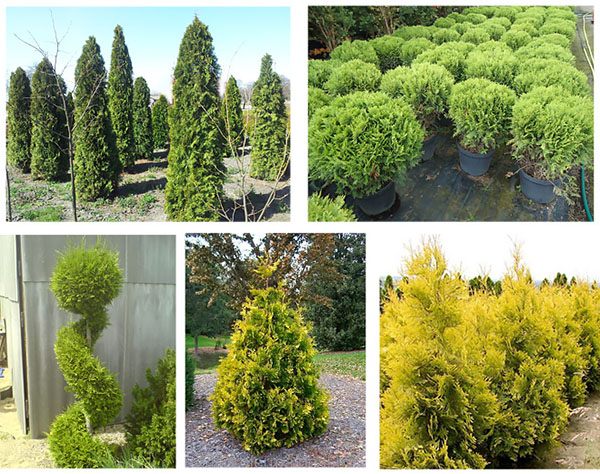
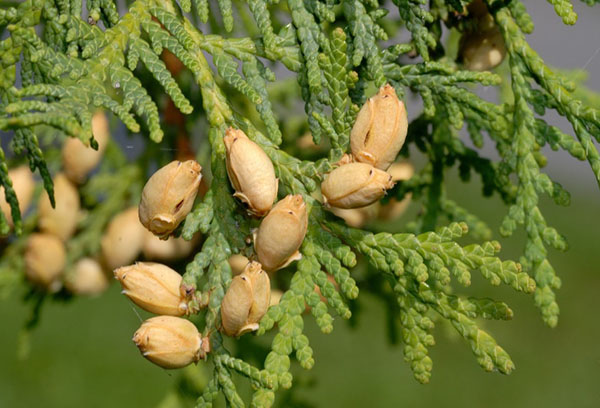

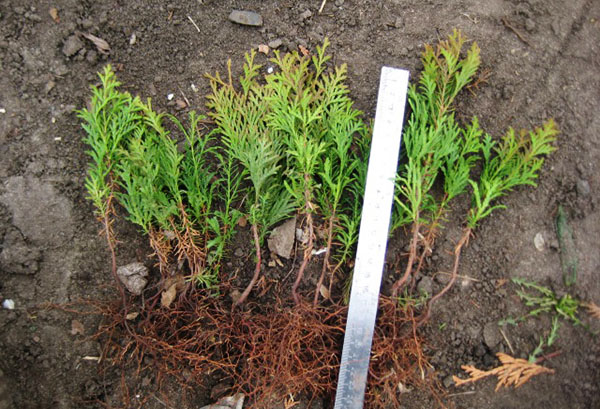
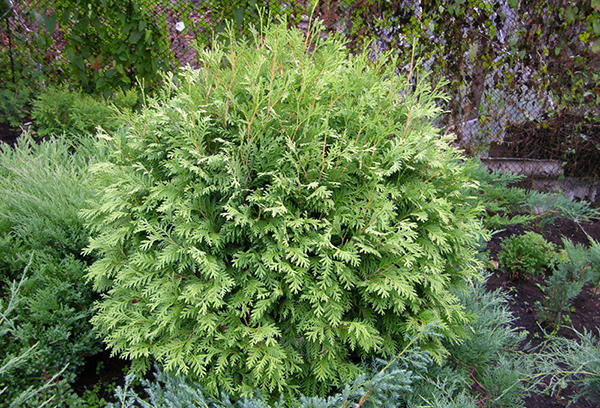

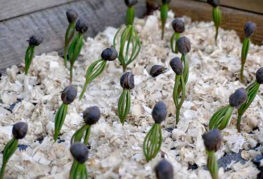
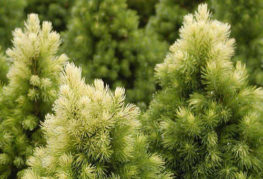
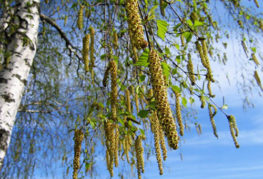
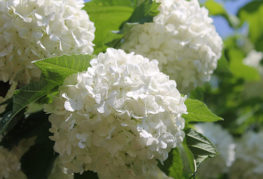
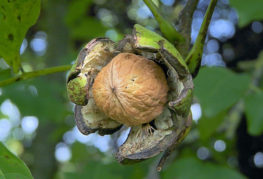
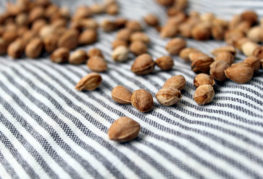
and will be published shortly.